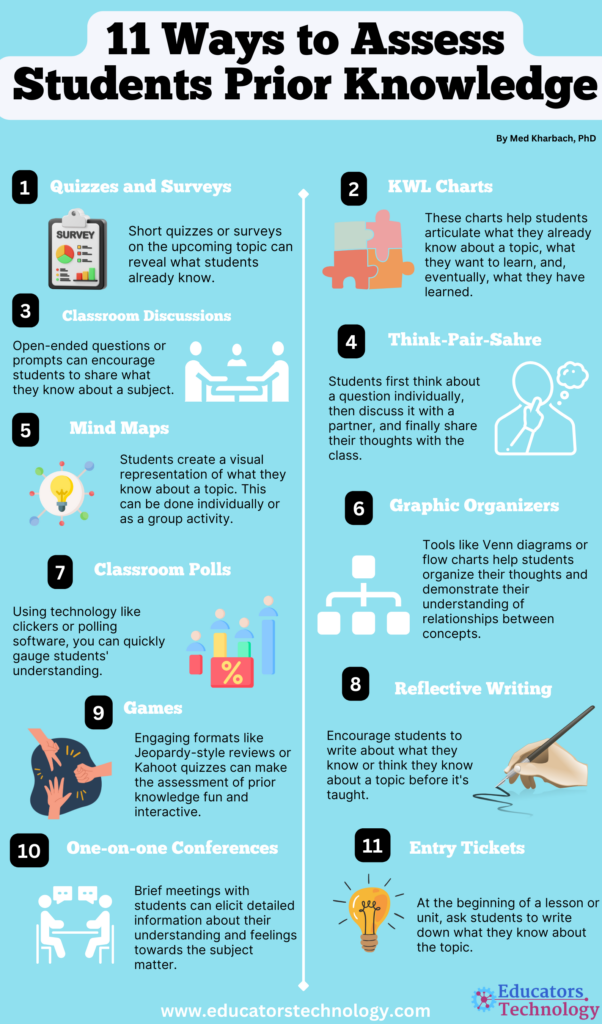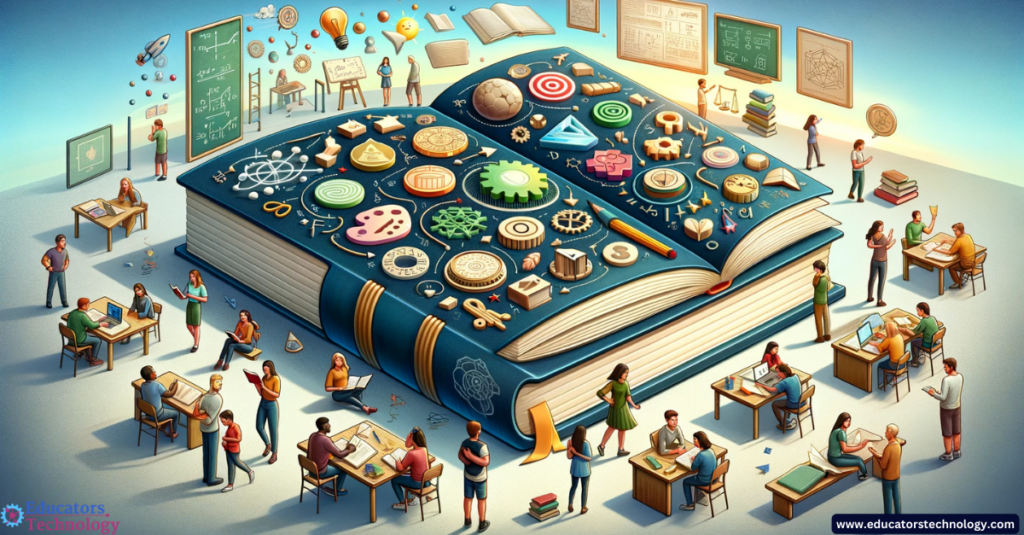As educators, one of our primary goals is to make learning as effective and engaging as possible. To achieve this, understanding the foundational knowledge that students bring into our classrooms is crucial. This foundational knowledge, known as ‘prior knowledge’, plays a pivotal role in shaping how students perceive, understand, and interact with new information. But what exactly is prior knowledge, and why is it so essential in the learning process?
Prior knowledge refers to the information, concepts, skills, and attitudes that students have acquired before encountering new learning material. This can stem from previous academic experiences, personal interests, cultural backgrounds, or everyday life experiences. Prior knowledge acts as a lens through which students view and make sense of new learning opportunities. It influences their ability to absorb, connect, and apply new information.
The importance of prior knowledge in education cannot be overstated. It’s the bridge that links new concepts to familiar ideas, helping students to construct new understanding in meaningful and relatable ways. When educators effectively tap into and build upon this existing knowledge, they can significantly enhance the learning experience, making it more relevant, engaging, and impactful for students.
In this post, we delve into various strategies educators can use to assess students’ prior knowledge. From interactive classroom activities like quizzes and mind maps to reflective practices like learning logs and self-assessments, these methods offer a diverse range of ways to gauge what students know and how they think.
Understanding students’ starting points can inform our teaching methods, allowing us to tailor our instruction to meet their unique needs and interests. Whether you’re a seasoned educator or new to the profession, these strategies are designed to enrich your teaching toolkit and enhance your classroom practice.
If you’re interested in gaining a deeper understanding of the concept of prior knowledge and its significance in education, be sure to read my dedicated post on this topic. There, you’ll find insights and in-depth discussions that will further illuminate the crucial role of prior knowledge in shaping successful learning experiences.
Ways to Assess Prior Knowledge
Here are some practical ways to use to assess prior knowledge:
1. Quizzes and Surveys
-
Purpose: To quickly and efficiently gauge students’ baseline knowledge about a topic.
-
Implementation: Use digital tools for ease of analysis, and include a mix of multiple-choice, true/false, and short-answer questions. Surveys can also include questions about students’ attitudes or interests related to the topic.
2. Classroom Discussions
-
Purpose: To encourage students to articulate their existing knowledge and opinions.
-
Implementation: Pose open-ended questions and facilitate a discussion where every student gets a chance to speak. This method is excellent for gauging students’ depth of understanding and revealing misconceptions.
3. Think-Pair-Share
-
Purpose: To promote individual reflection followed by collaborative discussion.
-
Implementation: After a question is posed, students first think about their answer individually, then discuss it with a partner, and finally share with the larger group. This method can be particularly effective for shy students.
4. KWL Charts
-
Purpose: To help students organize their thoughts about what they already know (K), what they want to learn (W), and what they have learned by the end of a lesson or unit (L).
-
Implementation: Use KWL charts as a visual tool at the start and end of a unit. It’s a great way to document learning progress.
5. Mind Maps
-
Purpose: To visually represent students’ knowledge and understanding of a topic.
-
Implementation: Students draw or use digital tools to create mind maps, linking concepts and ideas. This method can be particularly insightful for understanding how students see connections between concepts.
6. Graphic Organizers
-
Purpose: To help students structure their knowledge and understand relationships between concepts.
-
Implementation: Use tools like Venn diagrams, flow charts, or cause-and-effect diagrams. These are particularly useful in subjects where understanding relationships or processes is key.
7. Classroom Polls
-
Purpose: To quickly gather students’ responses to questions or prompts.
-
Implementation: Use clickers or online polling software. This method provides immediate feedback and can be used to spark discussions or guide lesson pacing.
8. Reflective Writing
-
Purpose: To encourage deeper thinking and personal connection to the topic.
-
Implementation: Have students write journals or short essays on what they know or think about a topic. This method can reveal students’ attitudes, misconceptions, and depth of understanding.
9. Games
-
Purpose: To assess knowledge in an engaging, low-stakes environment.
-
Implementation: Use educational games or quizzes, like Kahoot or Jeopardy-style reviews. This approach can make learning fun and encourage participation.
10. One-on-One Conferences
-
Purpose: To gain detailed insights into individual student’s understanding and feelings about a subject.
-
Implementation: Schedule brief meetings with each student to discuss their knowledge and thoughts on the subject. This method is particularly effective for understanding individual student needs and challenges.
11. Entry Tickets
-
Purpose: To ascertain what students know about a topic at the beginning of a lesson or unit.
-
Implementation: Ask students to write down what they know about the topic on a piece of paper (entry ticket) as they enter the class. Review these to tailor your instruction to their level.
12. Exit Tickets
-
Purpose: To assess what students have learned during a lesson and how it connects to their prior knowledge.
-
Implementation: At the end of a lesson, ask students to write a brief response to a prompt or question. This can help gauge the effectiveness of the lesson and students’ integration of new knowledge with what they already knew.
13. Peer Teaching Activities
-
Purpose: To allow students to articulate and share their understanding with others.
-
Implementation: Assign students to teach a concept to their peers. This method not only reveals the teacher’s grasp of the subject but also enhances the learners’ understanding.
14. Case Studies
-
Purpose: To apply theoretical knowledge to practical, real-world scenarios.
-
Implementation: Present case studies relevant to the topic and ask students to analyze them based on their existing knowledge. This can be a powerful tool in subjects like science, social studies, or literature.
15. Role-Playing
-
Purpose: To explore and express understanding in a dynamic, engaging way.
-
Implementation: In subjects like history or literature, role-playing historical events or literary scenarios can reveal students’ understanding of characters, motivations, and contexts.
16. Conceptual Interviews
-
Purpose: To delve deeply into students’ understanding of key concepts.
-
Implementation: Conduct informal, conversational interviews focusing on how students explain and understand core concepts of your subject.
17. Anecdotal Records
-
Purpose: To document observations of students’ behaviors and conversations that indicate their level of understanding.
-
Implementation: Keep ongoing records of informal observations during class activities, discussions, and group work. This method provides insights into students’ thought processes and misconceptions.
18. Learning Logs
-
Purpose: To track students’ thoughts, understanding, and questions over time.
-
Implementation: Students keep regular logs or diaries of what they are learning, questions they have, and connections they are making. This is particularly useful for long-term projects or units.
19. Portfolio Review
-
Purpose: To assess students’ progress and knowledge accumulation over time.
-
Implementation: Review a collection of students’ work over the course of a semester or year. This holistic approach can provide a comprehensive view of their learning journey.
20. Problem-Solving Tasks
-
Purpose: To assess application and analytical skills.
-
Implementation: Give students a problem related to the topic and observe their approach to solving it. This method is particularly effective in mathematics and science.
Final thoughts
Indeed, understanding and assessing students’ prior knowledge is a cornerstone of effective teaching and learning. Such knowledge helps teachers and educators create lessons that are more engaging, relevant, and more impactful in terms of student learning and achievement.
As you continue to explore and share these strategies through your blogs, remember that the journey of education is as much about understanding the learners as it is about delivering content. Each student brings a unique set of experiences, knowledge, and perspectives into the classroom, and acknowledging this diversity can transform the way we teach.
The post 20 Ways to Assess Prior Knowledge appeared first on Educators Technology.
 Latinos Media
Latinos Media 

